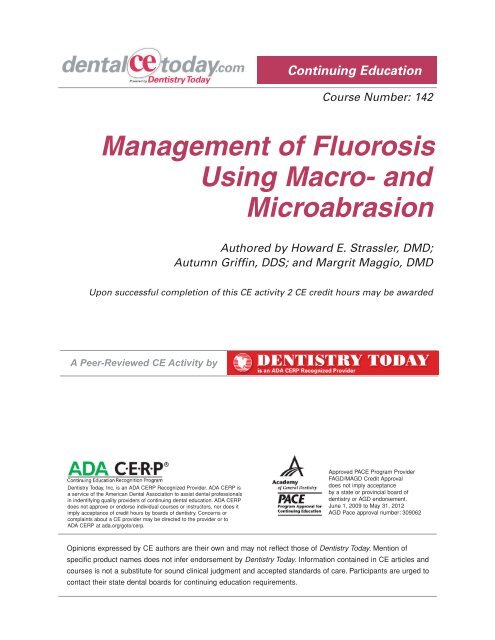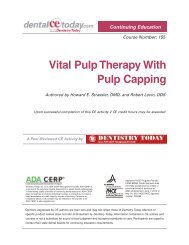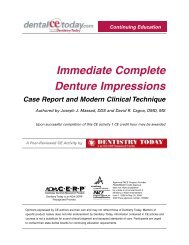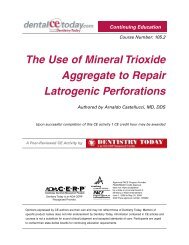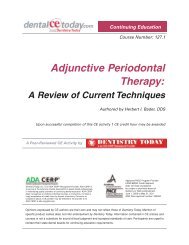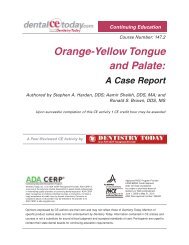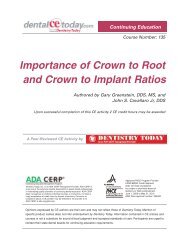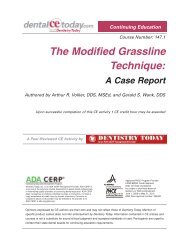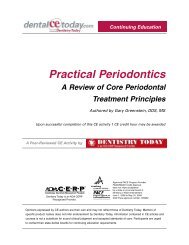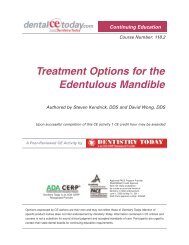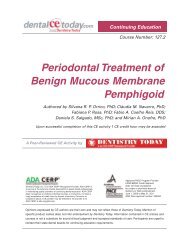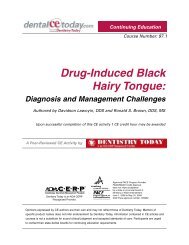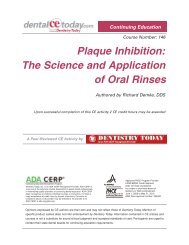Management of Fluorosis Using Macro- and ... - DentalCEToday
Management of Fluorosis Using Macro- and ... - DentalCEToday
Management of Fluorosis Using Macro- and ... - DentalCEToday
Create successful ePaper yourself
Turn your PDF publications into a flip-book with our unique Google optimized e-Paper software.
Continuing Education<br />
Course Number: 142<br />
<strong>Management</strong> <strong>of</strong> <strong>Fluorosis</strong><br />
<strong>Using</strong> <strong>Macro</strong>- <strong>and</strong><br />
Microabrasion<br />
Authored by Howard E. Strassler, DMD;<br />
Autumn Griffin, DDS; <strong>and</strong> Margrit Maggio, DMD<br />
Upon successful completion <strong>of</strong> this CE activity 2 CE credit hours may be awarded<br />
A Peer-Reviewed CE Activity by<br />
Dentistry Today, Inc, is an ADA CERP Recognized Provider. ADA CERP is<br />
a service <strong>of</strong> the American Dental Association to assist dental pr<strong>of</strong>essionals<br />
in indentifying quality providers <strong>of</strong> continuing dental education. ADA CERP<br />
does not approve or endorse individual courses or instructors, nor does it<br />
imply acceptance <strong>of</strong> credit hours by boards <strong>of</strong> dentistry. Concerns or<br />
complaints about a CE provider may be directed to the provider or to<br />
ADA CERP at ada.org/goto/cerp.<br />
Approved PACE Program Provider<br />
FAGD/MAGD Credit Approval<br />
does not imply acceptance<br />
by a state or provincial board <strong>of</strong><br />
dentistry or AGD endorsement.<br />
June 1, 2009 to May 31, 2012<br />
AGD Pace approval number: 309062<br />
Opinions expressed by CE authors are their own <strong>and</strong> may not reflect those <strong>of</strong> Dentistry Today. Mention <strong>of</strong><br />
specific product names does not infer endorsement by Dentistry Today. Information contained in CE articles <strong>and</strong><br />
courses is not a substitute for sound clinical judgment <strong>and</strong> accepted st<strong>and</strong>ards <strong>of</strong> care. Participants are urged to<br />
contact their state dental boards for continuing education requirements.
Continuing Education<br />
Recommendations for Fluoride Varnish Use in Caries <strong>Management</strong><br />
<strong>Management</strong> <strong>of</strong> <strong>Fluorosis</strong> <strong>Using</strong><br />
<strong>Macro</strong>- <strong>and</strong> Microabrasion<br />
Effective Date: 10/1/2011 Expiration Date: 10/1/2013<br />
LEARNING OBJECTIVES<br />
After reading this article, the individual will learn:<br />
• How fluoride is protective <strong>of</strong> enamel in the carious process.<br />
• Definition, categories, <strong>and</strong> clinical appearance <strong>of</strong> enamel<br />
fluorosis.<br />
• A technique for treating enamel fluorosis using micro- <strong>and</strong><br />
macroabrasion.<br />
ABOUT THE AUTHORS<br />
Dr. Strassler is a pr<strong>of</strong>essor, in the Division <strong>of</strong><br />
Operative Dentistry, Department <strong>of</strong> Endodontics,<br />
Prosthodontics <strong>and</strong> Operative<br />
Dentistry, University <strong>of</strong> Maryl<strong>and</strong> Dental<br />
School, Baltimore, Md. He can be reached<br />
via e-mail at hstrassler@umaryl<strong>and</strong>.edu.<br />
Disclosure: Dr. Strassler reports no disclosures.<br />
Dr. Griffin is a resident in the general<br />
practice dental residency, New Haven<br />
Hospital, Yale University, New Haven,<br />
Conn. She can be reached at<br />
autumn.griffin@ynhh.org.<br />
Disclosure: Dr. Griffin reports no disclosures.<br />
Dr. Maggio is an assistant pr<strong>of</strong>essor,<br />
clinician educator <strong>and</strong> the director <strong>of</strong><br />
operative dentistry, Department <strong>of</strong><br />
Preventive <strong>and</strong> Restorative Sciences,<br />
University <strong>of</strong> Pennsylvania School <strong>of</strong><br />
Dental Medicine, Philadelphia, Pa. She<br />
can be reached at mmaggio@pobox.upenn.edu.<br />
Disclosure: Dr. Maggio reports no disclosures.<br />
INTRODUCTION<br />
Water fluoridation is considered to be one <strong>of</strong> the significant<br />
public health measures <strong>of</strong> the 20th century. 1 During tooth<br />
development, fluoride becomes incorporated into the<br />
enamel matrix as fluorapatite, making the enamel more<br />
resistant to acid attack by bacteria <strong>and</strong> subsequent tooth<br />
demineralization. Further, fluoride is protective <strong>of</strong> enamel for<br />
erupted teeth through an equilibrium <strong>of</strong> demineralizationremineralization<br />
during early caries formation. Through the<br />
use <strong>of</strong> water fluoridation there has been a significant decline<br />
in dental caries in the United States. 2<br />
Despite the evidence that supports the benefits <strong>of</strong><br />
fluoride in caries prevention, when higher than necessary<br />
levels <strong>of</strong> fluoride are present, enamel fluorosis can pose an<br />
aesthetic problem for some patients. This article will<br />
discuss enamel fluorosis, the aesthetic challenges it can<br />
present for certain patients, <strong>and</strong> a conservative aesthetic<br />
treatment modality for a patient who presented with mild to<br />
moderate fluorosis.<br />
ENAMEL FLUOROSIS<br />
Dental fluorosis is defined as hypomineralization <strong>of</strong> enamel<br />
resulting from excessive ingestion <strong>of</strong> fluoride during tooth<br />
development. It is characterized by diffuse opacities on the<br />
enamel surface. These are differentiated from other<br />
conditions by the characteristic bilaterally symmetric<br />
distribution <strong>of</strong> the enamel defects. The degree to which the<br />
enamel is affected is dependent upon the duration, timing,<br />
<strong>and</strong> intensity <strong>of</strong> the fluoride concentration. 1,3 In its mild<br />
form, most commonly the teeth present with small white<br />
streaks <strong>and</strong> the enamel appears mottled (Figure 1). As the<br />
severity <strong>of</strong> the condition increases, black <strong>and</strong> brown stains<br />
develop. Moderate fluorosis will demonstrate white<br />
Figure 1.<br />
An example <strong>of</strong> mild<br />
fluorosis discoloration.<br />
1
Continuing Education<br />
<strong>Management</strong> <strong>of</strong> <strong>Fluorosis</strong> <strong>Using</strong> <strong>Macro</strong>- <strong>and</strong> Microabrasion<br />
streaking with brownish staining (Figure 2). Severe fluorosis<br />
has the appearance <strong>of</strong> very dark brown staining <strong>and</strong> in<br />
some cases enamel surface defects (Figure 3).<br />
For a small number <strong>of</strong> patients, the degree <strong>of</strong> fluorosis<br />
can be an aesthetic concern. 3-5 The primary author has<br />
found over the years that in many cases, patients with very<br />
mild <strong>and</strong> mild to moderate fluorosis are not aware <strong>of</strong> the<br />
minor discoloration present <strong>and</strong> have no aesthetic concerns.<br />
In those cases where patients have moderate to severe<br />
fluorosis, the discoloration can be <strong>of</strong> aesthetic concern.<br />
<strong>Fluorosis</strong> is a developmental phenomenon <strong>of</strong> the<br />
enamel that presents in both primary <strong>and</strong> permanent teeth.<br />
The origins <strong>of</strong> fluorosis are not completely understood;<br />
however, current research suggests that superfluous<br />
amounts <strong>of</strong> fluoride cause retention <strong>of</strong> amelogenin proteins<br />
in the developing tooth structure, thereby inhibiting enamel<br />
maturation. This interference results in porosities in the<br />
enamel at the time <strong>of</strong> tooth eruption. Specifically, recent<br />
animal <strong>and</strong> human studies indicate that the role <strong>of</strong> fluoride<br />
is likely due to its interaction with Ca 2+ ions; excess F<br />
intake has been shown to indirectly reduce the amount <strong>of</strong><br />
available Ca 2+ ions, which in turn limits the number <strong>of</strong><br />
calcium-dependent proteases available to remove enamel<br />
matrix proteins. This elimination <strong>of</strong> enamel matrix proteins<br />
is necessary for adequate enamel maturation. 6-9<br />
Studies in United States school children have reported<br />
fluorosis as high as 50% to 60% in the 1980s <strong>and</strong> in the<br />
range <strong>of</strong> 40% to 48% through the 1990s <strong>and</strong> 2000s. 8,10-14<br />
Dental fluorosis has been evaluated by the US Department<br />
<strong>of</strong> Health <strong>and</strong> Human Services Centers for Disease Control<br />
<strong>and</strong> Prevention (CDC) <strong>and</strong> Prevention National Center <strong>of</strong><br />
Health Statistics using the dental fluorosis classification<br />
described by Dean (Table 1).The findings were characterized<br />
as unaffected, questionable, very mild, mild, <strong>and</strong><br />
moderate/severe. From the data reported for dental fluorosis<br />
for adolescents <strong>and</strong> adults from 1999 to 2002, the majority <strong>of</strong><br />
persons examined were either unaffected or had<br />
questionable fluorosis (Table 2). For persons with a diagnosis<br />
<strong>of</strong> dental fluorosis, the rate that was mild was twice as<br />
prevalent for 16- to 19-year-olds when compared to 20- to 39-<br />
year-olds (6.7% versus 3.3%). Moderate/severe fluorosis<br />
also was higher for the 16- to 19-year-olds when compared<br />
to the 20 to 39 year olds (4.0% versus 1.8%). 14<br />
Figure 2.<br />
An example <strong>of</strong> moderate<br />
fluorosis staining.<br />
Figure 3.<br />
An example <strong>of</strong> severe<br />
fluorosis staining <strong>and</strong><br />
enamel surface defects.<br />
MULTIPLE SOURCES OF FLUORIDE<br />
Recommendations for fluoride supplements for children <strong>and</strong><br />
adolescents have been endorsed by the ADA <strong>and</strong> the<br />
Academy <strong>of</strong> Pediatric Dentistry for many years. In 1994, a<br />
change in the recommendations for fluoride supplements<br />
based upon the child’s age was made in response to<br />
concerns about the increase in the prevalence <strong>of</strong><br />
fluorosis. 1,15,16 These changes are noted in Table 3.<br />
The majority <strong>of</strong> fluoride ingestion is typically thought to<br />
be through foods, beverages, <strong>and</strong> supplements. 17-24 Water<br />
is the primary provider <strong>of</strong> fluoride. Recommendations for<br />
total dietary fluoride intake should be calculated based<br />
upon body weight using the formula <strong>of</strong> 0.05 mg/kg/day. 25 An<br />
analysis <strong>of</strong> fluoride exposures <strong>and</strong> ingestion from multiple<br />
sources may be responsible for higher than optimal<br />
amounts <strong>of</strong> fluoride required for caries prevention. 26,27<br />
Even children in nonfluoridated areas benefit from foods<br />
<strong>and</strong> beverages processed in fluoridated areas. 28 Sources<br />
<strong>of</strong> fluoride exposure <strong>and</strong> ingestion for children from dietary<br />
<strong>and</strong> nondietary sources include toothpastes, 4,26,29-32<br />
carbonated s<strong>of</strong>t drinks, 22 infant formula, 4,33,34 prescribed<br />
supplements, 26,28,35,36 <strong>and</strong> fluoride mouthrinses <strong>and</strong> gels.<br />
Recent recommendations concerning use <strong>of</strong> reconstituted<br />
infant formula <strong>and</strong> a fluoridated dentifrice point to the<br />
recommendation that parents monitor their use. 4<br />
Heilman <strong>and</strong> coworkers 22 examined the fluoride content<br />
2
<strong>of</strong> 332 carbonated beverages in Iowa. Their<br />
results revealed that fluoride levels ranged<br />
from 0.02 to 1.28 parts per million (ppm) with<br />
a mean level <strong>of</strong> 0.72 ppm. Fluoride levels<br />
exceeded 0.60 ppm for 71% <strong>of</strong> the products.<br />
Further, from this study no generalization<br />
could be made about same company/same<br />
product results. Different sites <strong>of</strong> bottling<br />
production revealed different fluoride levels.<br />
Variation in fluoride content reflects the fact<br />
that bottling <strong>of</strong> beverages utilizes the local<br />
water supply.<br />
It is difficult to monitor fluoride ingestion<br />
levels for children. When one considers that<br />
fluoride uptake can occur from the water<br />
supply, prescribed fluoride supplements,<br />
infant formula, dentifrices, fluoride mouthrinses,<br />
s<strong>of</strong>t drinks, <strong>and</strong> reconstituted juices,<br />
among other sources, it is not surprising<br />
that the incidence <strong>of</strong> fluorosis in the United<br />
States has been increasing. 34,37-41<br />
Further, with the increase in new<br />
immigrants to the United States, fluorosis<br />
can be observed due to endemic fluorosis<br />
in other countries. 42-50 For example, an<br />
unusual source <strong>of</strong> fluoride (not from foods<br />
or beverages) has been reported in Kenya<br />
<strong>and</strong> affects other east African nations as<br />
well. A 1986 epidemiological study <strong>of</strong><br />
dental fluorosis in Kenya stated that in fact<br />
“dental fluorosis has been endemic to<br />
Eastern Africa <strong>and</strong> in particular Kenya for<br />
many years since the Great Rift Valley,<br />
which is known to have volcanic activity,<br />
passes through Kenya.” Although it is<br />
believed that the main source <strong>of</strong> fluoride is from the drinking<br />
water (in some rural parts <strong>of</strong> Kenya there are 2 ppm fluoride<br />
in the drinking water with the corresponding incidence <strong>of</strong><br />
fluorosis being 100%), the volcanic soil <strong>of</strong> Kenya has been<br />
found to also have very high concentrations <strong>of</strong> fluoride. During<br />
the dry season in Kenya, the dust contains fluoride<br />
concentrations between 2,800 ppm <strong>and</strong> 5,600 ppm. 51<br />
Continuing Education<br />
<strong>Management</strong> <strong>of</strong> <strong>Fluorosis</strong> <strong>Using</strong> <strong>Macro</strong>- <strong>and</strong> Microabrasion<br />
Table 1. Criteria for Dean’s <strong>Fluorosis</strong> Index<br />
SCORE<br />
Normal<br />
Questionable<br />
Very Mild<br />
Mild<br />
Moderate<br />
Severe<br />
CRITERIA<br />
The enamel represents the usual translucent semivitriform<br />
type <strong>of</strong> structure. The surface is smooth, glossy, <strong>and</strong> usually<br />
<strong>of</strong> a pale creamy white color.<br />
The enamel discloses slight aberrations from the<br />
translucency <strong>of</strong> normal enamel, ranging from a few white<br />
flecks to occasional white spots. This classification is<br />
utilized in those instances where a definite diagnosis <strong>of</strong> the<br />
mildest form <strong>of</strong> fluorosis is not warranted <strong>and</strong> a<br />
classification <strong>of</strong> “normal" is not justified.<br />
Small, opaque, paper-white areas scattered irregularly over<br />
the tooth but not involving as much as 25% <strong>of</strong> the tooth<br />
surface. Frequently included in this classification are teeth<br />
showing no more than about one to 2 mm <strong>of</strong> white opacity<br />
at the tip <strong>of</strong> the summit <strong>of</strong> the cusps <strong>of</strong> the bicuspids<br />
or second molars.<br />
The white opaque areas in the enamel <strong>of</strong> the teeth are<br />
more extensive but do not involve as much as 50%<br />
<strong>of</strong> the tooth.<br />
All enamel surfaces <strong>of</strong> the teeth are affected, <strong>and</strong> the<br />
surfaces subject to attrition show wear. Brown stain is<br />
frequently a disfiguring feature.<br />
Includes teeth formerly classified as “moderately severe<br />
<strong>and</strong> severe.” All enamel surfaces are affected <strong>and</strong><br />
hypoplasia is so marked that the general form <strong>of</strong> the tooth<br />
may be affected. The major diagnostic sign <strong>of</strong> this<br />
classification is discrete or confluent pitting. Brown stains<br />
are widespread <strong>and</strong> teeth <strong>of</strong>ten present a<br />
corroded-like appearance.<br />
Source: Dean HT, 1942. Health Effects <strong>of</strong> Ingested Fluoride. Washington, DC: National<br />
Academy <strong>of</strong> Sciences; 1993:169.<br />
MINIMALLY INVASIVE AESTHETIC TREATMENT<br />
OPTIONS FOR MILD TO MODERATE DENTAL<br />
FLUOROSIS<br />
Concerns about the aesthetic appearance <strong>of</strong> teeth with fluorosis<br />
have led to proposed new guidelines for fluoridation <strong>of</strong> drinking<br />
water. 52 The goal <strong>of</strong> fluoride supplements is to provide an<br />
optimal amount <strong>of</strong> fluoride to reduce the risk <strong>of</strong> dental caries.<br />
3
Recent recommendations reflect<br />
changes from the previous levels<br />
<strong>of</strong> fluoride to a more optimal<br />
level <strong>of</strong> fluoride <strong>of</strong> 0.7 mg/L. 52<br />
These changes reflect the fact<br />
that the ingestion <strong>of</strong> fluoride<br />
can come from multiple<br />
sources, resulting in a need for<br />
a lower level <strong>of</strong> fluoride in<br />
optimally fluoridated drinking<br />
water. The recommendations<br />
also take into account that fluoride supplements need only<br />
be considered for patients at moderate to high risk for<br />
dental caries <strong>and</strong> even then may be unnecessary if patients<br />
are receiving adequate fluoride from other sources.<br />
The majority <strong>of</strong> patients with fluorosis have mild <strong>and</strong> very<br />
mild conditions. Depending on the severity <strong>of</strong> fluorosis <strong>and</strong> its<br />
clinical appearance, restorative treatments can change the<br />
aesthetic appearance <strong>of</strong> teeth. Decisions for changes should<br />
be based upon the patient’s perception regarding whether<br />
there is a need for treatment. <strong>Fluorosis</strong> staining is within the<br />
enamel. In cases <strong>of</strong> mild fluorosis, the enamel discoloration is<br />
superficial. For moderate <strong>and</strong> severe fluorosis, the enamel<br />
staining <strong>and</strong> mottling can penetrate to deeper<br />
enamel levels. For cases <strong>of</strong> mild fluorosis <strong>of</strong><br />
aesthetic concern to the patient, vital<br />
bleaching can be successful in achieving a<br />
change that the patient desires. 53 When the<br />
patient presents with mild-moderate flourosis,<br />
there may be the need for a microabrasion or<br />
macroabrasion technique.<br />
Microabrasion refers to the use <strong>of</strong> a<br />
hydrochloric acid abrasive paste to remove<br />
the superficial enamel staining. 54-57 In<br />
those cases where the fluorosis may be<br />
deeper in the superficial enamel but still<br />
mild in discoloration, a combined use <strong>of</strong> a<br />
fine abrasive diamond (50- to 75-µm grit<br />
size) in a high-speed h<strong>and</strong>piece with water<br />
spray provides for a more rapid removal <strong>of</strong><br />
the discolored enamel <strong>and</strong> has been<br />
referred to as macroabrasion. 58 When the<br />
superficial enamel is removed, the white<br />
Continuing Education<br />
<strong>Management</strong> <strong>of</strong> <strong>Fluorosis</strong> <strong>Using</strong> <strong>Macro</strong>- <strong>and</strong> Microabrasion<br />
Table 2. Dental <strong>Fluorosis</strong> in the United States 1999 to 2002, Based<br />
Upon Characteristics—CDC Data (from cdc.gov.mmwr/PDF/ss/ss5403.pdf)<br />
Age Group Unaffected Questionable Very Mild Mild Moderate/Severe<br />
6 to 11 59.8% 11.8% 19.8% 5.8% 2.7%<br />
12 to 15 51.5% 12.0% 25.3% 7.7% 3.6%<br />
16 to 19 58.3% 10.2% 20.8% 6.7% 4.0%<br />
20 to 39 74.9% 8.8% 11.1% 3.3% 1.8%<br />
speckled mottling <strong>of</strong> enamel reveals a more yellow enamel<br />
color beneath the surface. For some patients, the loss <strong>of</strong> the<br />
white speckled enamel to yellow is not acceptable. For<br />
these cases, a combined microabrasion/macroabrasion<br />
with vital bleaching is an aesthetically acceptable<br />
treatment. 59,60<br />
CASE REPORT<br />
A 20-year-old female patient was screened at the dental<br />
clinic for routine dental care. Her chief complaint was to<br />
remove <strong>and</strong>/or minimize the noticeable brown/yellow<br />
staining <strong>of</strong> her teeth. She wanted the least invasive <strong>and</strong><br />
Table 3. Changes in Flouride Supplement<br />
Dosage Schedule, 1979 <strong>and</strong> 1994 1,15,16<br />
1979 Concentration <strong>of</strong> Fluoride Ion in Drinking Water (ppm)<br />
Age < 0.3 0.3 to 0.7 > 0.7<br />
2 weeks to 2 years 0.25 mg/day none none<br />
2 to 3 years 0.50 mg/day 0.25 mg/day none<br />
3 to 16 years 1.00 mg/day 0.50 mg/day none<br />
1994 Concentration <strong>of</strong> Fluoride Ion in Drinking Water (ppm)<br />
Age < 0.3 0.3 to 0.6 > 0.6<br />
Birth to 6 months none none none<br />
6 months to 3 years 0.25 mg/day none none<br />
3 to 6 years 0.50 mg/day 0.25 mg/day none<br />
6 to 16 years 1.00 mg/day 0.50 mg/day none<br />
4
Continuing Education<br />
<strong>Management</strong> <strong>of</strong> <strong>Fluorosis</strong> <strong>Using</strong> <strong>Macro</strong>- <strong>and</strong> Microabrasion<br />
most cost effective treatment to change her smile. A review<br />
<strong>of</strong> her medical history <strong>and</strong> past dental history revealed no<br />
contraindications to dental treatment. In consideration <strong>of</strong><br />
her age, the patient was not interested in treatment options<br />
that involved significant removal <strong>of</strong> tooth structure, such as<br />
porcelain or composite resin veneers which had previously<br />
been suggested to her from her previous dentist. The<br />
patient’s desire to change the appearance <strong>of</strong> her teeth in<br />
the aesthetic zone was to improve her smile <strong>and</strong> thereby<br />
her confidence. From the appearance <strong>of</strong> her teeth, a<br />
diagnosis <strong>of</strong> mild to moderate fluorosis staining<br />
(determined by using Dean’s <strong>Fluorosis</strong> Index) was present<br />
on the anterior <strong>and</strong> posterior teeth in the aesthetic zone<br />
(white mottled enamel hypomineralization), with the most<br />
significant staining occurring on the maxillary anterior teeth;<br />
teeth Nos. 8 <strong>and</strong> 9 contained dark brown streaks in the<br />
middle third <strong>of</strong> the facial surfaces (Figure 4).<br />
A review <strong>of</strong> her past history <strong>and</strong> a complete dental<br />
examination revealed her country <strong>of</strong> origin as Kenya. She<br />
reported childhood friends as having the same discoloration<br />
<strong>of</strong> their teeth. As previously noted, Kenya is associated with<br />
endemic fluorosis. A treatment plan was presented to the<br />
patient that would fulfill her request for minimally invasive<br />
treatment which proposed macroabrasion/microabrasion <strong>of</strong><br />
the superficial enamel staining. Upon completion <strong>of</strong><br />
treatment, the tooth shade would be evaluated. If the patient<br />
desired further whitening, it was decided that at-home<br />
bleaching treatment would be provided.<br />
Phase 1: Enamel Abrasion Phase<br />
After receiving a routine oral prophylaxis, the maxillary teeth<br />
in the aesthetic zone (Nos. 4 to 13) were isolated with a<br />
dental dam to protect the gingival tissues when the acidic<br />
microabrasion paste was to be used (Figure 5). A combined<br />
enamel macroabrasion/microabrasion technique was<br />
decided to be the most effective way to treat the<br />
hypomineralized defects <strong>of</strong> the maxillary first premolars,<br />
canines, lateral <strong>and</strong> central incisors. Enamel macroabrasion<br />
refers to the use <strong>of</strong> either medium or fine grit diamond<br />
abrasives or multifluted finishing burs with a high-speed<br />
h<strong>and</strong>piece with air-water spray to remove the superficial layer<br />
<strong>of</strong> the enamel. 58,60 Enamel microabrasion refers to the use<br />
Figure 4.<br />
Preoperative view <strong>of</strong><br />
moderate<br />
fluorosis with patient<br />
desiring a color change<br />
<strong>and</strong> treatment.<br />
Figure 5.<br />
Dental dam applied.<br />
Figure 6.<br />
<strong>Macro</strong>abrasion <strong>of</strong> the<br />
facial surfaces <strong>of</strong> the<br />
teeth using a 50-µm grit<br />
fine diamond with a highspeed<br />
h<strong>and</strong>piece with airwater<br />
spray.<br />
Figure 7.<br />
Application <strong>of</strong> Opalustre<br />
microabrasion paste<br />
(Ultradent Products).<br />
Figure 8.<br />
Rubbing the<br />
microabrasion paste into<br />
the enamel surfaces <strong>of</strong><br />
the maxillary incisors<br />
with specialized brush<br />
embedded in cup at a<br />
speed <strong>of</strong> 1,000 rpm.<br />
<strong>of</strong> a low concentration acid combined with an abrasive agent<br />
as a water soluble gel or paste that would be applied to the<br />
enamel surface with an extremely low-speed rotary<br />
5
Continuing Education<br />
<strong>Management</strong> <strong>of</strong> <strong>Fluorosis</strong> <strong>Using</strong> <strong>Macro</strong>- <strong>and</strong> Microabrasion<br />
h<strong>and</strong>piece pressure applicator for precise compression <strong>of</strong> the<br />
compound on the tooth surface so that splattering <strong>of</strong> the<br />
compound would be eliminated or minimized.<br />
For this case, speed reduction was accomplished with<br />
an electric h<strong>and</strong>piece (Bien-Air Dental). Specialized torque<br />
converter speed reduction adapters can also be used. Use<br />
<strong>of</strong> the ultra-low-speed rotary application makes the<br />
procedure safer, easier, <strong>and</strong> quicker. 60,61 The current<br />
formulation for microabrasion pastes is a low concentration<br />
hydrochloric acid (6.6%), silicon carbide abrasive, <strong>and</strong> silica<br />
gel as a binding agent. This paste in fact etches the enamel<br />
surface more aggressively than the use <strong>of</strong> phosphoric acid<br />
used for adhesive restorative dentistry. 61<br />
To accomplish macroabrasion/microabrasion, the facial<br />
surfaces <strong>of</strong> the treated teeth were lightly abraded with a<br />
flame-shaped fine grit (50 µm) diamond (8862F [Brasseler<br />
USA]) using a high-speed h<strong>and</strong>piece with air-water spray<br />
(Figure 6) to remove the superficial enamel<br />
dysmineralization layer to a depth <strong>of</strong> approximately 0.2 to<br />
0.3 mm. After completion <strong>of</strong> the rotary macroabrasion, the<br />
microabrasion paste (Opalustre [Ultradent Products]) was<br />
applied to the facial surfaces <strong>of</strong> the treated maxillary teeth<br />
(Figure 7). <strong>Using</strong> a right angle latch type slow-speed h<strong>and</strong>piece<br />
running the motor at 1,000 rpm, a hybrid bristle<br />
brush-cup was used to apply the microabrasion paste for 3<br />
separate applications <strong>of</strong> 30 to 40 seconds each (Figure 8).<br />
Between each application the microabrasion paste was<br />
rinsed <strong>and</strong> dried from the tooth surfaces (Figure 9). This<br />
procedure was repeated 3 times (Figure 10). At the<br />
completion <strong>of</strong> the macroabrasion/microabrasion technique<br />
the etched enamel surfaces were polished with a cupshaped<br />
porcelain polishing rubber abrasive (Jazz [SS White<br />
Burs]) to smooth <strong>and</strong> polish the enamel surface (Figure 11).<br />
To remineralize the acid attached enamel surface the teeth<br />
were treated with a topical sodium fluoride (NuPro<br />
[DENTSPLY International]) in a fluoride tray. Then an<br />
amorphous calcium phosphate paste (MI Paste Plus [GC<br />
America]) was rubbed onto the enamel surfaces with a<br />
gloved finger.<br />
The dental dam was removed <strong>and</strong> the patient viewed the<br />
result <strong>of</strong> treatment. She was pleased with the result from the<br />
immediate removal <strong>of</strong> the dark staining on her maxillary<br />
anterior teeth (Figure 12). The patient was informed that<br />
Figure 9.<br />
Appearance <strong>of</strong> teeth after<br />
the first application.<br />
Figure 10.<br />
Appearance <strong>of</strong> teeth after<br />
third application.<br />
Figure 11.<br />
Polishing the etched<br />
enamel surfaces with<br />
a porcelain polishing<br />
rubber abrasive (Jazz<br />
[SS White Burs]).<br />
Figure 12.<br />
Postoperative view <strong>of</strong><br />
macroabrasion/microabrasion<br />
treatment.<br />
Figure 13.<br />
Postoperative view<br />
after 4 weeks <strong>of</strong> tray<br />
bleaching.<br />
because <strong>of</strong> the dental dam isolation <strong>and</strong> the etching process<br />
<strong>of</strong> the microabrasion paste, evaluation <strong>of</strong> the final color <strong>and</strong><br />
appearance <strong>of</strong> the teeth was to be done one week after<br />
6
Continuing Education<br />
<strong>Management</strong> <strong>of</strong> <strong>Fluorosis</strong> <strong>Using</strong> <strong>Macro</strong>- <strong>and</strong> Microabrasion<br />
treatment. In case there would be the need for postoperative<br />
tooth bleaching, maxillary <strong>and</strong> m<strong>and</strong>ibular impressions were<br />
made for subsequent bleaching tray fabrication if indicated.<br />
The patient did not return until 3 weeks after treatment<br />
because <strong>of</strong> travel plans.<br />
Phase 2: Tray Bleaching<br />
The second phase <strong>of</strong> the treatment was initiated<br />
approximately 3 weeks later (the patient traveled back to<br />
Kenya in the interim). <strong>Using</strong> a Classical Vita Shade Guide<br />
(Vident) it was determined that the teeth treated were now<br />
predominantly an A2 shade. When removing the superficial<br />
brownish-white enamel dysmineralization hypomineralization,<br />
it is not unusual for the final shade <strong>of</strong> the teeth to be slightly<br />
yellower than the original appearance (whitish speckled<br />
discoloration due to fluorosis <strong>of</strong> the teeth). This was observed<br />
with this patient.The patient elected to whiten her teeth further<br />
using vital tray bleaching.<br />
Fabricated bleaching trays were delivered to the patient<br />
along with a 15% carbamide peroxide with potassium<br />
nitrate <strong>and</strong> fluoride bleaching gel (Opalescence 15%PF<br />
[Ultradent Products]) to be used with overnight application<br />
each night for 4 weeks. The patient was told that if she was<br />
unable to bleach overnight to use the bleaching trays for at<br />
least 2 hours each day. During bleaching, the patient<br />
reported mild sensitivity to the initial bleaching application.<br />
She treated the tooth sensitivity using a recommendation<br />
<strong>of</strong> placing a desensitizing toothpaste (Sensodyne<br />
[GlaxoSmithKline]) in the bleaching tray one hour prior to<br />
bleaching, 62 then cleaning the tray <strong>of</strong> the toothpaste <strong>and</strong><br />
continuing with the bleaching regimen. One week <strong>of</strong> using<br />
the desensitizing toothpaste was all that was necessary to<br />
control the sensitivity.<br />
The patient reported being able to follow the overnight<br />
regimen <strong>of</strong> bleaching. After 4 weeks, the tooth shade <strong>and</strong><br />
appearance was evaluated <strong>and</strong> determined to be a shade<br />
B1 (Figure 13). The patient was pleased with the final<br />
aesthetic result.<br />
CONCLUSION<br />
Tooth discoloration due to fluorosis is an aesthetic problem<br />
for certain patients. While there is a range <strong>of</strong> restorative<br />
interventions that can be used to change the appearance <strong>of</strong><br />
fluorosed teeth, the goal <strong>of</strong> minimally invasive treatment for<br />
mild-moderate fluorosis is the one that should be evaluated<br />
first. For the case presented in this article, a minimally<br />
invasive treatment option <strong>of</strong> macroabrasion/microabrasion<br />
followed by tooth whitening with bleaching trays was shown<br />
to be a satisfactory approach for the aesthetic treatment <strong>of</strong><br />
moderate fluorosis. In the United States, new<br />
recommendations for reducing the optimal level <strong>of</strong> fluoride<br />
for water fluoridation are addressing aesthetic concerns<br />
without putting teeth at risk for caries.<br />
The current evidence demonstrates that when a diagnosis<br />
<strong>of</strong> fluorosis has been made, the majority <strong>of</strong> cases are very mild<br />
or mild <strong>and</strong> do not pose aesthetic problems that require<br />
treatment unless it is <strong>of</strong> concern to the patient. For the primary<br />
author, in cases where fluorosis is evident for a child, it is<br />
typically the parent who has identified the discoloration <strong>and</strong><br />
has questions about the appearance <strong>of</strong> the teeth. For some<br />
mild fluorosis discoloration <strong>and</strong> for moderate/severe fluorosis<br />
elective treatment to change the aesthetic appearance <strong>of</strong> the<br />
teeth can many times be accomplished with minimally invasive<br />
treatment using vital bleaching or combinations <strong>of</strong><br />
macroabrasion/microabrasion with bleaching to provide the<br />
patient with an aesthetically acceptable result. For more severe<br />
fluorosis with dark discolorations <strong>and</strong> surface pitting, adhesive<br />
restorative dentistry may be necessary to fulfill a patient’s<br />
aesthetic desires.<br />
7
Continuing Education<br />
<strong>Management</strong> <strong>of</strong> <strong>Fluorosis</strong> <strong>Using</strong> <strong>Macro</strong>- <strong>and</strong> Microabrasion<br />
REFERENCES<br />
1. Centers for Disease Control <strong>and</strong> Prevention. Achievements<br />
in public health, 1900-1999: fluoridation <strong>of</strong> drinking water to<br />
prevent dental caries. JAMA. 2000;283:1283-1286.<br />
2. Ismail AI, Hasson H. Fluoride supplements, dental caries<br />
<strong>and</strong> fluorosis: a systematic review. J Am Dent Assoc.<br />
2008;139:1457-1468.<br />
3. Aoba T, Fejerskov O. Dental fluorosis: chemistry <strong>and</strong> biology.<br />
Crit Rev Oral Biol Med. 2002;13:155-170.<br />
4. Levy SM, Br<strong>of</strong>fitt B, Marshall TA, et al. Associations between<br />
fluorosis <strong>of</strong> permanent incisors <strong>and</strong> fluoride intake from<br />
infant formula, other dietary sources <strong>and</strong> dentifrice during<br />
early childhood. J Am Dent Assoc. 2010;141:1190-1201.<br />
5. Martins CC, Feitosa NB, Vale MP, et al. Parents’ perceptions<br />
<strong>of</strong> oral health conditions depicted in photographs <strong>of</strong> anterior<br />
permanent teeth. Eur J Paediatr Dent. 2010;11:203-209.<br />
6. Wright JT, Chen SC, Hall KI, et al. Protein characterization <strong>of</strong><br />
fluorosed human enamel. J Dent Res. 1996;75:1936-1941.<br />
7. Limeback H. Enamel formation <strong>and</strong> the effects <strong>of</strong> fluoride.<br />
Community Dent Oral Epidemiol. 1994;22:144-147.<br />
8. Beltrán-Aguilar ED, Barker L, Dye BA. Prevalence <strong>and</strong><br />
severity <strong>of</strong> dental fluorosis in the United States, 1999-2004.<br />
NCHS Data Brief. 2010;(53):1-8.<br />
9. Cutress TW, Suckling GW. Differential diagnosis <strong>of</strong> dental<br />
fluorosis. J Dent Res. 1990;69(special issue):714-721.<br />
10. Centers for Disease Control <strong>and</strong> Prevention.<br />
Recommendations for using fluoride to prevent <strong>and</strong> control<br />
dental caries in the United States. MMWR Recomm Rep.<br />
2001;50(RR-14):1-42.<br />
11. Oral Health in America: A Report <strong>of</strong> the Surgeon General.<br />
Rockville, MD: US Department <strong>of</strong> Health <strong>and</strong> Human<br />
Services; 2000. surgeongeneral.gov/library/oralhealth.<br />
Accessed June 20, 2011.<br />
12. Clark DC. Trends in prevalence <strong>of</strong> dental fluorosis in North<br />
America. Community Dent Oral Epidemiol. 1994;22:148-152.<br />
13. Rozier RG. The prevalence <strong>and</strong> severity <strong>of</strong> enamel fluorosis<br />
in North American children. J Public Health Dent.<br />
1999;59:239-246.<br />
14. Beltrán-Aguilar ED, Barker LK, Canto MT, et al; Centers for<br />
Disease Control <strong>and</strong> Prevention. Surveillence for dental<br />
caries, dental sealants, tooth retention, edentulism, <strong>and</strong><br />
enamel fluorosis—United States, 1988-1994 <strong>and</strong> 1999-2002.<br />
MMWR Surveill Summ. 2005;54:1-43. cdc.gov.mmwr/PDF/ss/<br />
ss5403.pdf. Accessed June 20, 2011.<br />
15. Dosage schedule for dietary fluoride supplements.<br />
Proceedings <strong>of</strong> a workshop. Chicago, Ill. January 31 to<br />
February 1, 1994. J Public Health Dent. 1999;59:203-281.<br />
16. American Academy <strong>of</strong> Pediatrics. Committee on Nutrition.<br />
Fluoride supplementation: revised dosage schedule.<br />
Pediatrics. 1979;63:150-152.<br />
17. Berg J, Gerweck C, Hujoel PP, et al. Evidence-based clinical<br />
recommendations regarding fluoride intake from<br />
reconstituted infant formula <strong>and</strong> enamel fluorosis: a report <strong>of</strong><br />
the American Dental Association Council on Scientific<br />
Affairs. J Am Dent Assoc. 2011;142:79-87.<br />
18. Steinmetz JE, Martinez-Mier EA, Jones JE, et al. Fluoride<br />
content <strong>of</strong> water used to reconstitute infant formula. Clin<br />
Pediatr (Phila). 2011;50:100-105.<br />
19. American Dental Association. Accepted Dental Therapeutics.<br />
33rd-40th eds. Chicago, IL: Council on Dental Therapeutics<br />
<strong>of</strong> the American Dental Association; 1969/1970-1984:399-<br />
402.<br />
20. Marya CM, Dhingra S, Marya V, et al. Relationship <strong>of</strong> dental<br />
caries at different concentrations <strong>of</strong> fluoride in endemic<br />
areas: an epidemiological study. J Clin Pediatr Dent.<br />
2010;35:41-45.<br />
21. Thippeswamy HM, Kumar N, An<strong>and</strong> SR, et al. Fluoride<br />
content in bottled drinking waters, carbonated s<strong>of</strong>t drinks<br />
<strong>and</strong> fruit juices in Davangere city, India. Indian J Dent Res.<br />
2010;21:528-530.<br />
22. Heilman JR, Kiritsy MC, Levy SM, et al. Assessing fluoride<br />
levels <strong>of</strong> carbonated s<strong>of</strong>t drinks. J Am Dent Assoc.<br />
1999;130:1593-1599.<br />
23. Levy SM, Guha-Chowdhury N. Total fluoride intake <strong>and</strong><br />
implications for dietary fluoride supplementation. J Public<br />
Health Dent. 1999;59:211-223.<br />
24. Levy SM, Kiritsy MC, Warren JJ. Sources <strong>of</strong> fluoride intake in<br />
children. J Public Health Dent. 1995;55:39-52.<br />
25. Institute <strong>of</strong> Medicine. Fluoride. In: Dietary Reference Intakes<br />
for Calcium, Phosphorus, Magnesium, Vitamin D, <strong>and</strong><br />
Fluoride. Washington, DC: National Academy Press;<br />
1997:288-313.<br />
26. Levy SM. Review <strong>of</strong> fluoride exposures <strong>and</strong> ingestion.<br />
Community Dent Oral Epidemiol. 1994;22:173-180.<br />
27. Rodrigues MH, Leite AL, Arana A, et al. Dietary fluoride<br />
intake by children receiving different sources <strong>of</strong> systemic<br />
fluoride. J Dent Res. 2009;88:142-145.<br />
28. Levy SM, Warren JJ, Davis CS, et al. Patterns <strong>of</strong> fluoride<br />
intake from birth to 36 months. J Public Health Dent.<br />
2001;61:70-77.<br />
29. Franzman MR, Levy SM, Warren JJ, et al. Fluoride dentifrice<br />
ingestion <strong>and</strong> fluorosis <strong>of</strong> the permanent incisors. J Am Dent<br />
Assoc. 2006;137:645-652.<br />
30. Moraes SM, Pessan JP, Ramires I, et al. Fluoride intake from<br />
regular <strong>and</strong> low fluoride dentifrices by 2-3-year-old children:<br />
influence <strong>of</strong> the dentifrice flavor. Braz Oral Res. 2007;21:234-240.<br />
31. de Almeida BS, da Silva Cardoso VE, Buzalaf MA. Fluoride<br />
ingestion from toothpaste <strong>and</strong> diet in 1- to 3-year-old<br />
Brazilian children. Community Dent Oral Epidemiol.<br />
2007;35:53-63.<br />
8
Continuing Education<br />
<strong>Management</strong> <strong>of</strong> <strong>Fluorosis</strong> <strong>Using</strong> <strong>Macro</strong>- <strong>and</strong> Microabrasion<br />
32. Oliveira MJ, Paiva SM, Martins LH, et al. Fluoride intake by<br />
children at risk for the development <strong>of</strong> dental fluorosis:<br />
comparison <strong>of</strong> regular dentifrices <strong>and</strong> flavoured dentifrices<br />
for children. Caries Res. 2007;41:460-466.<br />
33. Walton JL, Messer LB. Dental caries <strong>and</strong> fluorosis in breastfed<br />
<strong>and</strong> bottle-fed children. Caries Res. 1981;15:124-137.<br />
34. Pendrys DG, Katz RV, Morse DE. Risk factors for enamel<br />
fluorosis in a fluoridated population. Am J Epidemiol.<br />
1994;140:461-471.<br />
35. Marthaler RM. Fluoride supplements for systemic effects in<br />
caries prevention. In: Johansen E, Taves DR, Olsen TO, eds.<br />
Continuing Evaluation <strong>of</strong> the Use <strong>of</strong> Fluorides. Boulder, CO:<br />
Westview Press; 1979:33-59.<br />
36. Levy SM, Kiritsy MC, Slager SL, et al. Patterns <strong>of</strong> dietary<br />
fluoride supplement use during infancy. J Public Health Dent.<br />
1998;58:228-233.<br />
37. Levy SM, Hillis SL, Warren JJ, et al. Primary tooth fluorosis<br />
<strong>and</strong> fluoride intake during the first year <strong>of</strong> life. Community<br />
Dent Oral Epidemiol. 2002; 30:286-295.<br />
38. Osuji OO, Leake JL, Chipman ML, et al. Risk factors for<br />
dental fluorosis in a fluoridated community. J Dent Res.<br />
1988;67:1488-1492.<br />
39. Ismail AI, Messer JG. The risk <strong>of</strong> fluorosis in students<br />
exposed to a higher than optimal concentration <strong>of</strong> fluoride in<br />
well water. J Public Health Dent. 1996;56:22-27.<br />
40. Holm AK, Andersson R. Enamel mineralization disturbances<br />
in 12- year-old children with known early exposure to<br />
fluorides. Community Dent Oral Epidemiol. 1982;10:335-339.<br />
41. Kumar JV, Green EL, Wallace W, et al. Trends in dental<br />
fluorosis <strong>and</strong> dental caries prevalences in Newburgh <strong>and</strong><br />
Kingston, NY. Am J Public Health. 1989;79:565-569.<br />
42. Nirgude AS, Saiprasad GS, Naik PR, et al. An epidemiological<br />
study on fluorosis in an urban slum area <strong>of</strong> Nalgonda, Andhra<br />
Pradesh, India. Indian J Public Health. 2010;54:194-196.<br />
43. Gopalakrishnan P, Vasan RS, Sarma PS, et al. Prevalence <strong>of</strong><br />
dental fluorosis <strong>and</strong> associated risk factors in Alappuzha<br />
district, Kerala. Natl Med J India. 1999;12:99-103.<br />
44. Kadir RA, Al-Maqtari RA. Endemic fluorosis among 14-yearold<br />
Yemeni adolescents: an exploratory survey. Int Dent J.<br />
2010;60:407-410.<br />
45. Marya CM, Dhingra S, Marya V, et al. Relationship <strong>of</strong> dental<br />
caries at different concentrations <strong>of</strong> fluoride in endemic<br />
areas: an epidemiological study. J Clin Pediatr Dent.<br />
2010;35:41-45.<br />
46. Mwaniki DL, Courtney JM, Gaylor JD. Endemic fluorosis: an<br />
analysis <strong>of</strong> needs <strong>and</strong> possibilities based on case studies in<br />
Kenya. Soc Sci Med. 1994;39:807-813.<br />
47. Faye M, Diawara CK, Ndiaye KR, et al. Dental fluorosis <strong>and</strong><br />
dental caries prevalence in Senegalese children living in a<br />
high-fluoride area <strong>and</strong> consuming a poor fluoridated drinking<br />
water [in French]. Dakar Med. 2008;53:162-169.<br />
48. Ermi RB, Koray F, Akdeniz BG. Dental caries <strong>and</strong> fluorosis in<br />
low- <strong>and</strong> high-fluoride areas in Turkey. Quintessence Int.<br />
2003;34:354-360.<br />
49. Ibrahim YE, Bjorvatn K, Birkel<strong>and</strong> JM. Caries <strong>and</strong> dental<br />
fluorosis in a 0.25 <strong>and</strong> a 2.5 ppm fluoride area in the Sudan.<br />
Int J Paediatr Dent. 1997;7:161-166.<br />
50. Ferreira EF, Vargas AM, Castilho LS, et al. Factors associated to<br />
endemic fluorosis in Brazilian rural communities. Int J Environ<br />
Res Public Health. 2010;7:3115-3128.<br />
51. Manji F, Baelum V, Fejerskov O. Dental fluorosis in an area<br />
<strong>of</strong> Kenya with 2 ppm fluoride in the drinking water. J Dent<br />
Res. 1986;65:659-662.<br />
52. HHS <strong>and</strong> EPA announce new scientific assessments <strong>and</strong><br />
actions on fluoride [news release]. US Department <strong>of</strong> Health<br />
& Human Services; January 7, 2011. hhs.gov/news/press/<br />
2011pres/01/20110107a.html. Accessed June 20, 2011.<br />
53. Loyola-Rodriguez JP, Pozos-Guillen Ade J, Hern<strong>and</strong>ez-<br />
Hern<strong>and</strong>ez F, et al. Effectiveness <strong>of</strong> treatment with<br />
carbamide peroxide <strong>and</strong> hydrogen peroxide in subjects<br />
affected by dental fluorosis: a clinical trial. J Clin Pediatr<br />
Dent. 2003;28:63-67.<br />
54. Croll TP, Cavanaugh RR. Enamel color modification by<br />
controlled hydrochloric acid-pumice abrasion. I. Technique<br />
<strong>and</strong> examples. Quintessence Int. 1986;17:81-87.<br />
55. Croll TP, Cavanaugh RR. Enamel color modification by<br />
controlled hydrochloric acid-pumice abrasion. II. Further<br />
examples. Quintessence Int. 1986;17:157-164.<br />
56. Allen K, Agosta C, Estafan D. <strong>Using</strong> microabrasive material to<br />
remove fluorosis stains. J Am Dent Assoc. 2004;135:319-323.<br />
57. Croll TP. Enamel microabrasion for removal <strong>of</strong> superficial<br />
discoloration. J Esthet Dent. 1989;1:14-20.<br />
58. Coll JA, Jackson P, Strassler HE. Comparison <strong>of</strong> enamel<br />
microabrasion techniques: Prema Compound versus a 12-<br />
fluted finishing bur. J Esthet Dent. 1991;3:180-186.<br />
59. Higashi C, Dall’Agnol AL, Hirata R, et al. Association <strong>of</strong><br />
enamel microabrasion <strong>and</strong> bleaching: a case report. Gen<br />
Dent. 2008;56:244-249.<br />
60. Strassler HE. Clinical case report: treatment <strong>of</strong> mild-tomoderate<br />
fluorosis with a minimally invasive treatment plan.<br />
Compend Contin Educ Dent. 2010; 31:54-58.<br />
61. Croll TP. Enamel microabrasion: concept development. In:<br />
Croll TP. Enamel Microabrasion. Chicago, IL: Quintessence<br />
Publishing; 1991:37-41.<br />
62. Haywood VB, Cordero R, Wright K, et al. Brushing with a<br />
potassium nitrate dentifrice to reduce bleaching sensitivity.<br />
J Clin Dent. 2005;16:17-22.<br />
9
Continuing Education<br />
<strong>Management</strong> <strong>of</strong> <strong>Fluorosis</strong> <strong>Using</strong> <strong>Macro</strong>- <strong>and</strong> Microabrasion<br />
POST EXAMINATION INFORMATION<br />
To receive continuing education credit for participation in<br />
this educational activity you must complete the program<br />
post examination <strong>and</strong> receive a score <strong>of</strong> 70% or better.<br />
Traditional Completion Option:<br />
You may fax or mail your answers with payment to Dentistry<br />
Today (see Traditional Completion Information on following<br />
page). All information requested must be provided in order<br />
to process the program for credit. Be sure to complete your<br />
“Payment,” “Personal Certification Information,” “Answers,”<br />
<strong>and</strong> “Evaluation” forms. Your exam will be graded within 72<br />
hours <strong>of</strong> receipt. Upon successful completion <strong>of</strong> the postexam<br />
(70% or higher), a letter <strong>of</strong> completion will be mailed<br />
to the address provided.<br />
Online Completion Option:<br />
Use this page to review the questions <strong>and</strong> mark your<br />
answers. Return to dentalcetoday.com <strong>and</strong> sign in. If you<br />
have not previously purchased the program, select it from<br />
the “Online Courses” listing <strong>and</strong> complete the online<br />
purchase process. Once purchased the program will be<br />
added to your User History page where a Take Exam link<br />
will be provided directly across from the program title.<br />
Select the Take Exam link, complete all the program<br />
questions <strong>and</strong> Submit your answers. An immediate grade<br />
report will be provided. Upon receiving a passing grade,<br />
complete the online evaluation form. Upon submitting the<br />
form your Letter Of Completion will be provided<br />
immediately for printing.<br />
General Program Information:<br />
Online users may log in to dentalcetoday.com any time in<br />
the future to access previously purchased programs <strong>and</strong><br />
view or print letters <strong>of</strong> completion <strong>and</strong> results.<br />
POST EXAMINATION QUESTIONS<br />
1. During tooth development fluoride becomes<br />
incorporated into which portion <strong>of</strong> the tooth making it<br />
more resistant to acid attack by bacteria<br />
a. Periodontal ligament.<br />
b. Enamel.<br />
c. Dentin.<br />
d. Pulp.<br />
2. Water fluoridation has been described as being a<br />
significant public health measure. Through the use <strong>of</strong><br />
fluoridation there has been a significant decline in what<br />
oral pathology<br />
a. Periodontal disease.<br />
b. Tooth crowding <strong>and</strong> misalignment.<br />
c. Tooth anomalies.<br />
d. Caries.<br />
3. Dental fluorosis is defined as:<br />
a. Hypomineralization <strong>of</strong> enamel resulting from excessive<br />
ingestion <strong>of</strong> fluoride during tooth development.<br />
b. Hypermineralization <strong>of</strong> enamel resulting from excessive<br />
ingestion <strong>of</strong> fluoride during tooth development.<br />
c. Hypomineralization <strong>of</strong> dentin resulting from excessive<br />
ingestion <strong>of</strong> fluoride during tooth development.<br />
d. Hypermineralization <strong>of</strong> dentin resulting from excessive<br />
ingestion <strong>of</strong> fluoride during tooth development.<br />
4. According to the article, the degree to which enamel is<br />
affected by fluoride causing fluorosis is dependent on<br />
the all the following EXCEPT:<br />
a. Duration <strong>of</strong> exposure to fluoride.<br />
b. Timing <strong>of</strong> when fluoride is administered.<br />
c. Intensity <strong>of</strong> fluoride concentration.<br />
d. The patients’ gender.<br />
5. The clinical appearance <strong>of</strong> mild fluorosis is:<br />
a. Dark yellowing <strong>of</strong> the enamel.<br />
b. Dark brown <strong>and</strong> black stains oriented with horizontal<br />
streaks within the enamel.<br />
c. Small white streaks with enamel mottling.<br />
d. Bluish translucency to the enamel.<br />
6. The clinical appearance <strong>of</strong> moderate fluorosis is:<br />
a. Dark yellowing <strong>of</strong> the enamel.<br />
b. Small translucent-bluish streaks on the enamel surface.<br />
c. White streaking with brownish staining <strong>of</strong> the enamel.<br />
d. Dark black streaks with white halos surrounding<br />
them within the enamel surface.<br />
7. The clinical appearance <strong>of</strong> severe fluorosis is:<br />
a. Dark yellowing <strong>of</strong> the enamel.<br />
b. Very dark brown staining with some cases having<br />
enamel defects.<br />
c. Slight white streaking <strong>of</strong> the enamel.<br />
d. Bluish translucency to the enamel.<br />
10
Continuing Education<br />
<strong>Management</strong> <strong>of</strong> <strong>Fluorosis</strong> <strong>Using</strong> <strong>Macro</strong>- <strong>and</strong> Microabrasion<br />
8. The majority <strong>of</strong> patients with enamel fluorosis have mild or<br />
very mild conditions. All conditions <strong>of</strong> mild <strong>and</strong> very mild<br />
enamel fluorosis require an aesthetic restorative intervention.<br />
a. Both statements are true.<br />
b. The first statement is true <strong>and</strong> the second statement<br />
is false.<br />
c. The first statement is false <strong>and</strong> the second statement<br />
is true.<br />
d. Both statements are false.<br />
9. In cases where the patient is concerned about the<br />
aesthetic appearance <strong>of</strong> mild-moderate fluorosis,<br />
conservative, minimally invasive treatment technique(s)<br />
that can be used is (are):<br />
a. Vital bleaching.<br />
b. <strong>Macro</strong>abrasion-microabrasion.<br />
c. <strong>Macro</strong>abrasion-microabrasion followed by vital bleaching.<br />
d. All are conservative, minimally invasive treatment<br />
techniques for mild-moderate fluorosis.<br />
10. Microabrasion refers to the use <strong>of</strong> a hydrochloric acid<br />
abrasive paste to remove the superficial enamel staining.<br />
In those cases where the fluorosis may be deeper in the<br />
superficial enamel but still mild in discoloration, a<br />
combined use <strong>of</strong> a fine abrasive diamond (50- to 75-µm<br />
grit size) in a high-speed h<strong>and</strong>piece with water spray<br />
provides for a more rapid removal <strong>of</strong> the discolored<br />
enamel <strong>and</strong> has been referred to as macroabrasion.<br />
a. Both statements are true.<br />
b. The first statement is true <strong>and</strong> the second statement is false.<br />
c. The first statement is false <strong>and</strong> the second statement is true.<br />
d. Both statements are false.<br />
11. Source(s) for fluoride exposure <strong>and</strong> ingestion for children<br />
from dietary <strong>and</strong> nondietary as reported in the dental<br />
literature include:<br />
a. Toothpaste.<br />
b. Carbonated s<strong>of</strong>t drinks.<br />
c. Infant formula.<br />
d. All the above are sources for fluoride exposure <strong>and</strong><br />
ingestion for children.<br />
12. When evaluating children for ingestion <strong>of</strong> fluoride it is<br />
not uncommon for the dental pr<strong>of</strong>essional to not<br />
include carbonated beverages as a potential source <strong>of</strong><br />
fluoride. From the study by Heilman <strong>and</strong> coworkers their<br />
conclusion was that:<br />
a. Carbonated beverages are not a source for fluoride<br />
ingestion.<br />
b. Different sites <strong>of</strong> bottling production for carbonated<br />
beverages can reveal different fluoride levels.<br />
c. Variation in fluoride content reflects the fact that bottling<br />
<strong>of</strong> beverages utilizes the local water supply.<br />
d. b <strong>and</strong> c.<br />
13. Because fluoride is ingested from multiple sources,<br />
there have been recent recommendations to lower the<br />
amount <strong>of</strong> fluoride in optimally fluoridated drinking<br />
water. These proposed changes are to lower the optimal<br />
level <strong>of</strong> fluoride to:<br />
a. 0.005 mg/L.<br />
b. 0.7 mg/L.<br />
c. 1.1 mg/L.<br />
d. 7.0 mg/L.<br />
14. Microabrasion as an aesthetic treatment technique<br />
refers to the use <strong>of</strong> an:<br />
a. Hydrochloric acid abrasive paste to remove superficial<br />
enamel staining.<br />
b. Hydr<strong>of</strong>luoric acid abrasive powders in a air abrasion<br />
device to remove superficial enamel staining.<br />
c. Mild fluoride rinse (1.1% sodium fluoride) to treat<br />
mottled enamel <strong>and</strong> dentin.<br />
d. Phosphoric acid gel to remove brown <strong>and</strong> black stains<br />
in the superficial enamel <strong>and</strong> root surfaces.<br />
15. <strong>Macro</strong>abrasion refers to an aesthetic treatment<br />
technique that uses:<br />
a. A 50-µm aluminum oxide particle in an air abrasion<br />
device to remove fluorosis discoloration.<br />
b. Abrasive pumice paste with phosphoric acid with a<br />
prophylaxis brush to remove fluorosis discoloration.<br />
c. Fine abrasive diamond (50- to 75-µm grit size) in a<br />
high-speed h<strong>and</strong>piece with water spray.<br />
d. A 10% sodium peroxide gel to whiten the enamel<br />
surfaces.<br />
16. When treating fluorosis discoloration that has a white<br />
speckled mottling <strong>of</strong> enamel, it is not uncommon that<br />
once the superficial enamel discoloration has been<br />
removed, the enamel has a more yellow appearance. In<br />
these cases a conservative treatment to achieve an<br />
acceptable aesthetic result as described in the article is:<br />
a. Full-coverage all-ceramic crowns.<br />
b. Combined microabrasion/macroabrasion with vital<br />
bleaching.<br />
c. No treatment is necessary, the patient will have to live<br />
with the yellow enamel shade.<br />
d. Three quarter crown preparations then restored with<br />
zirconia veneers.<br />
11
Continuing Education<br />
<strong>Management</strong> <strong>of</strong> <strong>Fluorosis</strong> <strong>Using</strong> <strong>Macro</strong>- <strong>and</strong> Microabrasion<br />
PROGRAM COMPLETION INFORMATION<br />
PERSONAL CERTIFICATION INFORMATION:<br />
If you wish to purchase <strong>and</strong> complete this activity<br />
traditionally (mail or fax) rather than online, you must<br />
provide the information requested below. Please be sure to<br />
select your answers carefully <strong>and</strong> complete the evaluation<br />
information. To receive credit you must answer at least 12 <strong>of</strong><br />
the 16 questions correctly.<br />
Complete online at: dentalcetoday.com<br />
TRADITIONAL COMPLETION INFORMATION:<br />
Last Name (PLEASE PRINT CLEARLY OR TYPE)<br />
First Name<br />
Pr<strong>of</strong>ession / Credentials<br />
Street Address<br />
Suite or Apartment Number<br />
License Number<br />
Mail or fax this completed form with payment to:<br />
Dentistry Today<br />
Department <strong>of</strong> Continuing Education<br />
100 Passaic Avenue<br />
Fairfield, NJ 07004<br />
Fax: 973-882-3622<br />
PAYMENT & CREDIT INFORMATION:<br />
Examination Fee: $40.00 Credit Hours: 2.0<br />
Note: There is a $10 surcharge to process a check drawn on<br />
any bank other than a US bank. Should you have additional<br />
questions, please contact us at (973) 882-4700.<br />
❏ I have enclosed a check or money order.<br />
❏ I am using a credit card.<br />
My Credit Card information is provided below.<br />
❏ American Express ❏ Visa ❏ MC ❏ Discover<br />
Please provide the following (please print clearly):<br />
City State Zip Code<br />
Daytime Telephone Number With Area Code<br />
Fax Number With Area Code<br />
E-mail Address<br />
ANSWER FORM: COURSE #: 142<br />
Please check the correct box for each question below.<br />
1. ❏ a ❏ b ❏ c ❏ d 9. ❏ a ❏ b ❏ c ❏ d<br />
2. ❏ a ❏ b ❏ c ❏ d 10. ❏ a ❏ b ❏ c ❏ d<br />
3. ❏ a ❏ b ❏ c ❏ d 11. ❏ a ❏ b ❏ c ❏ d<br />
4. ❏ a ❏ b ❏ c ❏ d 12. ❏ a ❏ b ❏ c ❏ d<br />
5. ❏ a ❏ b ❏ c ❏ d 13. ❏ a ❏ b ❏ c ❏ d<br />
6. ❏ a ❏ b ❏ c ❏ d 14. ❏ a ❏ b ❏ c ❏ d<br />
7. ❏ a ❏ b ❏ c ❏ d 15. ❏ a ❏ b ❏ c ❏ d<br />
8. ❏ a ❏ b ❏ c ❏ d 16. ❏ a ❏ b ❏ c ❏ d<br />
Exact Name on Credit Card<br />
Credit Card #<br />
Signature<br />
Approved PACE Program Provider<br />
FAGD/MAGD Credit Approval<br />
does not imply acceptance<br />
by a state or provincial board <strong>of</strong><br />
dentistry or AGD endorsement.<br />
June 1, 2009 to May 31, 2012<br />
AGD Pace approval number: 309062<br />
/<br />
Expiration Date<br />
Dentistry Today, Inc, is an ADA CERP Recognized<br />
Provider. ADA CERP is a service <strong>of</strong> the American<br />
Dental Association to assist dental pr<strong>of</strong>essionals in<br />
indentifying quality providers <strong>of</strong> continuing dental<br />
education. ADA CERP does not approve or endorse<br />
individual courses or instructors, nor does it imply<br />
acceptance <strong>of</strong> credit hours by boards <strong>of</strong> dentistry.<br />
Concerns or complaints about a CE provider may be<br />
directed to the provider or to ADA CERP at<br />
ada.org/goto/cerp.<br />
12<br />
PROGRAM EVAUATION FORM<br />
Please complete the following activity evaluation questions.<br />
Rating Scale: Excellent = 5 <strong>and</strong> Poor = 0<br />
Course objectives were achieved.<br />
Content was useful <strong>and</strong> benefited your<br />
clinical practice.<br />
Review questions were clear <strong>and</strong> relevant<br />
to the editorial.<br />
Illustrations <strong>and</strong> photographs were<br />
clear <strong>and</strong> relevant.<br />
Written presentation was informative<br />
<strong>and</strong> concise.<br />
How much time did you spend reading<br />
the activity <strong>and</strong> completing the test


